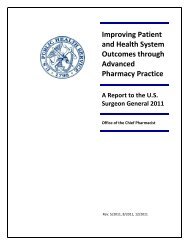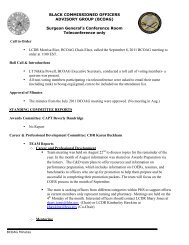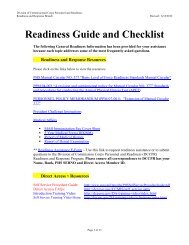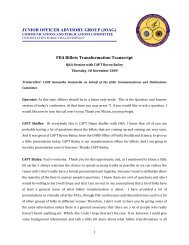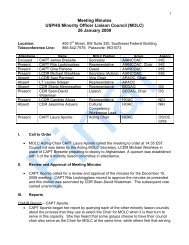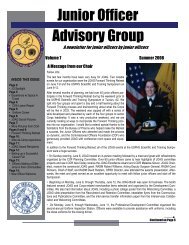Download PDF - U.S. Public Health Service Commissioned Corps
Download PDF - U.S. Public Health Service Commissioned Corps
Download PDF - U.S. Public Health Service Commissioned Corps
You also want an ePaper? Increase the reach of your titles
YUMPU automatically turns print PDFs into web optimized ePapers that Google loves.
U.S. <strong>Public</strong> <strong>Health</strong> <strong>Service</strong> <strong>Commissioned</strong> <strong>Corps</strong> BEST KEPT SECRETSFootnotes for Pay Comparison Table1. Dependent(s) are considered to be spouse and/or children; compensation table will be slightly different for deductions for individuals withoutdependents.2. The housing allowance which is called Basic Allowance for Housing (BAH) is dependent on the cost of living in the area where you are assignedand number of claimed dependents. See http://militarypay.defense.gov/mpcalcs/Calculators/RMC.aspx for the calculation of your exact housingallowance.3. 3. Variable Special Pay (VSP) is a monthly payment that is available to all medical officers based on years of creditable service which is defined asthe number of years an officer has been on active duty as a medical officer of the Uniformed <strong>Service</strong>s and/or the years spent participating in anaccredited medical internship or residency training while not on active duty in a Uniformed <strong>Service</strong>. VSP ranges from $5,000 to $12,000 annually.Board Certification Pay (BCP) is a monthly payment that requires current board certification. The amount ranges from $2,500 to $6,000 per year andis based on the number of years of creditable service.Retention Special Pay (RSP) is an annual payment of $15,000 for medical officers who execute a contract to remain on active duty for a specifiedterm of one or more years. Payment is made in a lump sum usually within 90 of the effective date of the contract. If other bonus pay contracts arenegotiated, they will have concurrent dating.Incentive Special Pay (ISP) is an annual payment for medical officers based on medical specialty. ISP ranges from $35,380 to $73,200 and requires aone-year contract.Multi-year Retention Bonus (MRB) is an annual payment for medical officers that ranges from $8,120 to $46,800 depending on the specialty trainingand the duration of the contract (See Incentive Special Pay and Multi-year Retention Bonus Table below). MRB requires, among other things, thata medical officer enter into a contract to remain on active duty for 2-4 years. Both MSB and RSP contracts must have concurrent dates. Isolatedhardship pay for officers at isolated or hard-to-fill locations ranges from $11,000 to $17,000 per year and is included in MRB when applicable.Not included in the table is the Assignment Special Pay (AIP) which is a monthly payment of up to $3,000 for medical officers in designated criticalpublic health assignments who execute a contract to remain on active duty active duty for a minimum of one year. Medical officers assigned to theIndian <strong>Health</strong> <strong>Service</strong> or Federal Bureau of Prisons are not eligible for this pay. See: http://dcp.psc.gov/eccis/documents/CCI6_3_1_02.pdf.4. A private sector employee who contributes $7,000 annually to a retirement account, with $3,500 matching funds by the employer, would receive$24,768 annually in 20 years, assuming an 8% rate of return. This annuity would run out of funds in 25 years, assuming a 4% rate of inflation. Thesame employee with the same contribution for 30 years would receive $61,313 annually, assuming an 8% rate of return. This annuity would alsorun out in 25 years time assuming a 4% rate of inflation. The <strong>Commissioned</strong> <strong>Corps</strong> Counterpart (I removed a redundant period) would contributenothing to his/her annuity, yet receive $64,910 annually after retiring as an O-6 after 20 years, $ 85,927 after 25 years, and $106,970 after 30 years (Iremoved in today’s money) and the annuity would not run out of funds in his/her lifetime no matter what the inflation rate may be. A voluntary, pretaxcontribution to the Thrift Savings Plan (TSP) may be made if an officer wishes to invest independently.5. Many states do not require officers on active duty to pay state income tax. Check applicable state tax codes. State tax for Civil <strong>Service</strong> and privatesector pay is estimated at a tax rate of 6%.6. Medical Insurance premiums and out of pocket expenses are based on the employee cost of a comparable comprehensive health insurance package.Figures taken from 2005 Rand Corporation study. (http://www.rand.org/pubs/monographs/2005/RAND_MG385.sum.pdf)7. Medical Officers with 25 years of service will be credited 5 additional years qualifying them for benefits similar to other officers who had served for 30years.WWW.FACEBOOK.COM/USPHS 800-279-1605 WWW.USPHS.GOV13




